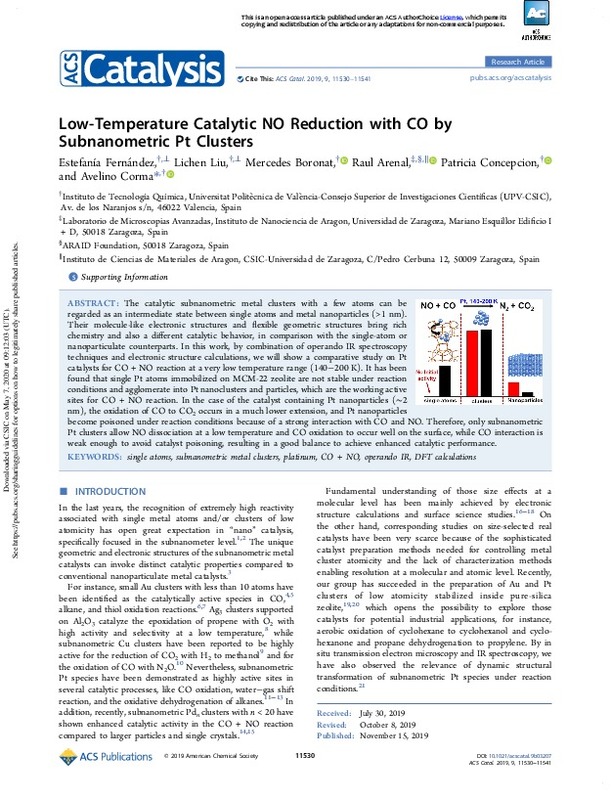Fernández-Villanueva, E.; Liu, L.; Boronat Zaragoza, M.; Arenal, R.; Concepción Heydorn, P.; Corma Canós, A. (2019). Low-Temperature Catalytic NO Reduction with CO by Subnanometric Pt Clusters. ACS Catalysis. 9(12):11530-11541. https://doi.org/10.1021/acscatal.9b03207
Por favor, use este identificador para citar o enlazar este ítem: http://hdl.handle.net/10251/150654
|
Título:
|
Low-Temperature Catalytic NO Reduction with CO by Subnanometric Pt Clusters
|
|
Autor:
|
 Fernández-Villanueva, Estefanía
Liu, Lichen
Fernández-Villanueva, Estefanía
Liu, Lichen

 Boronat Zaragoza, Mercedes
Arenal, Raul
Boronat Zaragoza, Mercedes
Arenal, Raul
 Concepción Heydorn, Patricia
Concepción Heydorn, Patricia

 Corma Canós, Avelino
Corma Canós, Avelino
|
|
Entidad UPV:
|
Universitat Politècnica de València. Instituto Universitario Mixto de Tecnología Química - Institut Universitari Mixt de Tecnologia Química
Universitat Politècnica de València. Departamento de Química - Departament de Química
|
|
Fecha difusión:
|
|
|
Resumen:
|
[EN] The catalytic subnanometric metal clusters with a few atoms can be regarded as an intermediate state between single atoms and metal nanoparticles (>1 nm). Their molecule-like electronic structures and flexible geometric ...[+]
[EN] The catalytic subnanometric metal clusters with a few atoms can be regarded as an intermediate state between single atoms and metal nanoparticles (>1 nm). Their molecule-like electronic structures and flexible geometric structures bring rich chemistry and also a different catalytic behavior, in comparison with the single-atom or nanoparticulate counterparts. In this work, by combination of operando IR spectroscopy techniques and electronic structure calculations, we will show a comparative study on Pt catalysts for CO + NO reaction at a very low temperature range (140-200 K). It has been found that single Pt atoms immobilized on MCM-22 zeolite are not stable under reaction conditions and agglomerate into Pt nanoclusters and particles, which are the working active sites for CO + NO reaction. In the case of the catalyst containing Pt nanoparticles (similar to 2 nm), the oxidation of CO to CO2 occurs in a much lower extension, and Pt nanoparticles become poisoned under reaction conditions because of a strong interaction with CO and NO. Therefore, only subnanometric Pt clusters allow NO dissociation at a low temperature and CO oxidation to occur well on the surface, while CO interaction is weak enough to avoid catalyst poisoning, resulting in a good balance to achieve enhanced catalytic performance.
[-]
|
|
Palabras clave:
|
Single atoms
,
Subnanometric metal clusters
,
Platinum
,
CO plus NO
,
Operando IR
,
DFT calculations
|
|
Derechos de uso:
|
Reconocimiento - No comercial (by-nc)
|
|
Fuente:
|
ACS Catalysis. (issn:
2155-5435
)
|
|
DOI:
|
10.1021/acscatal.9b03207
|
|
Editorial:
|
American Chemical Society
|
|
Versión del editor:
|
https://doi.org/10.1021/acscatal.9b03207
|
|
Código del Proyecto:
|
info:eu-repo/grantAgreement/EC/H2020/671093/EU/MATching zeolite SYNthesis with CATalytic activity/
...[+]
info:eu-repo/grantAgreement/EC/H2020/671093/EU/MATching zeolite SYNthesis with CATalytic activity/
info:eu-repo/grantAgreement/MINECO//SVP-2013-068146/ES/SVP-2013-068146/
info:eu-repo/grantAgreement/EC/H2020/823717/EU/Enabling Science and Technology through European Electron Microscopy/
info:eu-repo/grantAgreement/AEI/Plan Estatal de Investigación Científica y Técnica y de Innovación 2013-2016/MAT2017-82288-C2-1-P/ES/MATERIALES HIBRIDOS MULTIFUNCIONALES BASADOS EN NANO-UNIDADES ESTRUCTURALES ACTIVAS/
info:eu-repo/grantAgreement/MINECO//MAT2016-79776-P/ES/AJUSTE DE LAS PROPIEDADES OPTOELECTRONICAS DE NANOESTRUCTURAS: SU (TRANS)FORMACION Y ESTUDIOS AVANVAZADOS SOBRE SU CONFIGURACION ATOMICA Y ESTUCTURAL/
info:eu-repo/grantAgreement/Gobierno de Aragón//E13_17R/
info:eu-repo/grantAgreement/MINECO//SEV-2016-0683/
[-]
|
|
Agradecimientos:
|
This work has been supported by the European Union through the European Research Council (grant ERC-AdG-2014671093, SynCatMatch) and the Spanish government through the "Severo Ochoa Program" (SEV-2016-0683) and ...[+]
This work has been supported by the European Union through the European Research Council (grant ERC-AdG-2014671093, SynCatMatch) and the Spanish government through the "Severo Ochoa Program" (SEV-2016-0683) and MAT2017-82288-C2-1-P projects. L.L. thanks ITQ for providing a contract. E.F. thanks MINECO for her fellowship SVP-2013-068146. The authors also thank Microscopy Service of UPV for the TEM and STEM measurements. The HRSTEM studies were conducted at the Laboratorio de Microscopias Avanzadas, Universidad de Zaragoza, Spain. RA. acknowledges support from Spanish MINECO grant MAT2016-79776-P (AEI/FEDER, UE), from the Government of Aragon and the European Social Fund (grant number E13_17R, FEDER, UE), and from the European Union H2020 program "ESTEEM3" (grant number 823717). Red Espanola de Supercomputacion (RES) and Centre de Calcul de la Universitat de Valencia are acknowledged for computational resources and technical support.
[-]
|
|
Tipo:
|
Artículo
|









